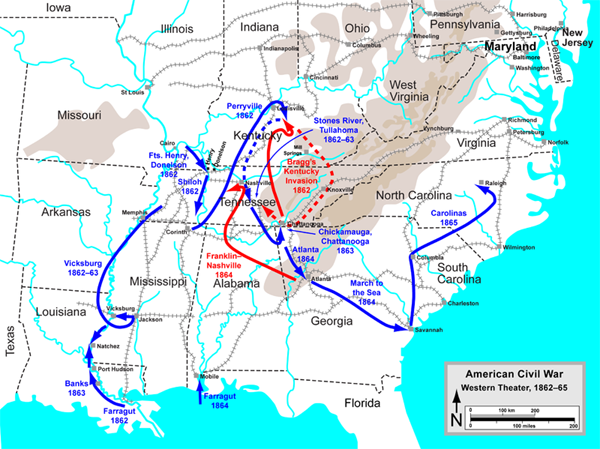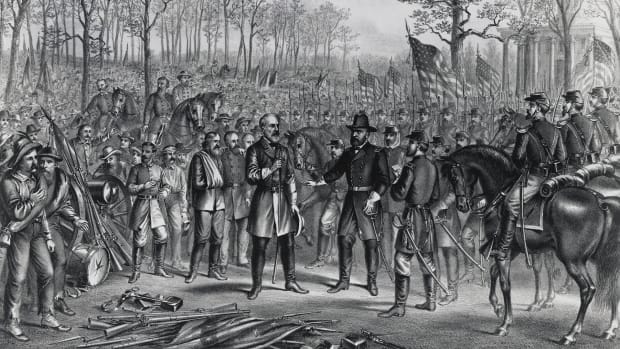The American Civil War was fought between the Federal army and the Confederate army due to various internal disagreements and differences of opinion. The Battle of Shiloh was one of the early wars fought after the actual commencement of the American Civil War. The Battle of Shiloh started on April 6th, 1862, and lasted till April 7th, 1862.
The Battle of Shiloh began almost a year after the American Civil War, which started on April 12th, 1861. Though the number of men involved was less and the duration was short, the Battle of Shiloh facts to be one of the greatest and most strategically significant battles fought during the Civil War. The Battle of Shiloh Civil War is also referred to as the Battle of Pittsburg landing due to the landmark of Pittsburg landing near the west bank of the Tennessee River.
The Western Theater:

In the September of 1861, Major General Ulysses S. Grant led the Army of the Tennessee to capture Kentucky and bought it under the Federal Union. The Union also stationed troops along the Mississippi River to threaten the Confederacy. The Confederacy counteracted and had stationed its troops at Fort Henry and Fort Donelson along the Cumberland River, which was situated along the border of Kentucky and Tennessee, in order to protect the city of Nashville.
The attack of the Army of Tennessee on the Forts Henry Donelson inflicted heavy losses and eventually led to the surrender due to weak security. By February 6th and February 16th, the Union had acquired Fort Henry and Fort Donelson, respectively, which were also parts of Western Tennessee. By February 25, General Don Carlos Buell and the Army of Ohio under his leadership had captured Nashville, Tennessee.
The Battle of Shiloh map primarily covers the regions of the Western Theater of the American Civil War, which includes Tennessee, Mississippi, Kentucky, Carolina, Florida, Alabama, and Georgia. Shiloh was actually named after Shiloh Church which was in the vicinity of the actual battle location.
Before the battle:

General Grant and General Buell combine their forces and form the Army of the Mississippi of the Federal Army. By March, General Henry Halleck ordered General Grant to set up around 44,000 men along the Tennessee River. The 16,000 men from Nashville under the Army of Ohio also joined with General Grant’s army.
The Confederate Army of Mississippi under General Albert Sidney Johnston was stationed at Corinth, Mississippi. General Johnston was one of the top-most prolific generals of the Confederates. The Confederate army included 55,000 men, and around 40,000 men started to march towards the Federal Union army stationed at the Tennessee River. General Johnston was in a rush to attack General Grant before the army union of Grant and Buell. The Union army stationed at Tennessee River didn’t have many defenses like fortifications and entrenchments for the enemies.
The main goal of General Johnston was to attack the Federal army and drive them to the west. General Johnston chose the Pittsburg swamp as the place of attack, but the arrival of General Johnston was delayed due to heavy rains.
The Battle of Shiloh:

General Johnston’s troops were ready to attack the Union by April 6th. But the problem was, the soldiers were tired and weary due to the travel. General Grant was not aware of the approaching Confederate forces. A group of night patrollers identified the Confederate troops and attacked them. The gun firing sounds had already alerted the Union army and General Grant, and they started to line up the battle line. General Sherman of the Union army lined up near Shiloh Church facing General Polk of the Confederate army.
General Beauregard, in charge of the army’s strategic command, who was also second-in-hand to General Johnston, commanded the military and directed his soldiers to lead the Union soldiers to move eastwards towards the Tennessee River on the contrary to the orders of General Johnston to make them move westwards back to the Union Territory. The Confederate army forces made the Union army back off and formed new defensive lineups.
General McClernand’s troops and General Sherman’s troops had retreated to alter the plans behind the Shiloh Chruch. The battle of Shiloh location was the Shiloh Church which eventually became the name of the fight itself. General Prentiss and General Hurlbut of the Federal army were stationed on the eastern side near the Tennessee River. They were stationed across a sunken road called Hornet’s Nest. The open road was the point where the Union army and the Confederate army fought.
The Union army was facing significant injuries due to the minie balls and the cannonballs. During the battle at Hornet’s nest, General Johnston was severely injured, and eventually, he died due to significant injuries. General Johnston was the highest-ranked man to die at a battle in the American Civil War. General Beauregard became the chief commander in charge, but he could not tackle the whole situation. General Grant’s army men have joined again to devise a new plan.
The current position was in accordance with the Federal army’s position as they had access to the Navy boats stationed in the Tennessee River. General Grant, who was currently in the outskirts of the battle location, gave orders for General Nelson to be stationed at the positions opposite of the Pittsburg point at the Tennessee River.
The comeback of the Union:

General Wallace was ordered to meet General Sherman’s troops on the other rear end near Shiloh Church. A slight misinterpretation from Wallace’s side was later rectified, and Wallace was able to join Sherman only by seven in the evening. General Buell’s Ohio troops also joined Grant’s army. The additional soldiers significantly reinforced the Federal army with a total of 45,000 men, while the Confederate army had only 20,000 men.
Continual attacks of the Union troops made the Confederate army fall back. The situation went out of the hands, and Beauregard subsequently ordered his men to move back to Corinth to their army base.The battle of Shiloh included continual fighting for two days and had casualties of around 13,000 from the Union army side and about 10,000 from the Confederate army side.
The Battle of Shiloh was considered a victory by both the Federal Union and the Confederates. But historians consider the Battle of Shiloh to be a loss for the Confederate army. In 1894, the Shiloh military park was created to remember and commemorate the participants of the Battle of Shiloh.
